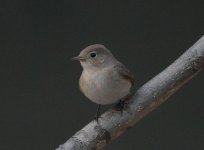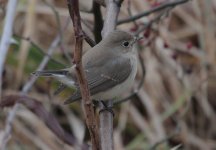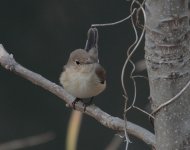I took these pics almost 2 years ago, late November 2009 in south Hokkaido Japan.
Taiga Flycatcher is a scarce migrant in Japan and had been recently spilt from Red Breasted Flycatcher. I assumed the latter was to the west and the former here in the east. One reader of my blog suggested at the time it may have been a Red Breasted (now a real rarity in Japan) but to be honest they look so similar I couldn't really tell the difference and assumed it was a Taiga Flycatcher and I forgot all about it.
Now a couple of others (on flickr) have suggested once again it may be a Red Breasted.
3 heavily cropped pics are attached. Any opinions gratefully received.......
Taiga Flycatcher is a scarce migrant in Japan and had been recently spilt from Red Breasted Flycatcher. I assumed the latter was to the west and the former here in the east. One reader of my blog suggested at the time it may have been a Red Breasted (now a real rarity in Japan) but to be honest they look so similar I couldn't really tell the difference and assumed it was a Taiga Flycatcher and I forgot all about it.
Now a couple of others (on flickr) have suggested once again it may be a Red Breasted.
3 heavily cropped pics are attached. Any opinions gratefully received.......






